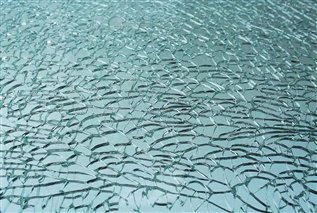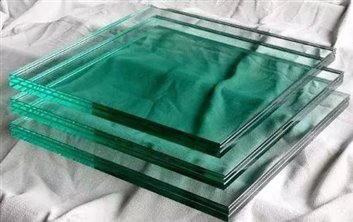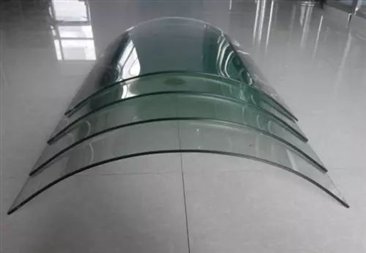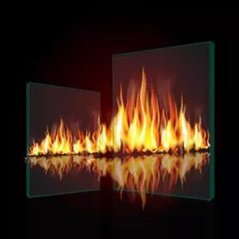Glass is an indispensable material component of modern architecture. Glass is used in different building parts. Especially for exterior windows, glass has become the most important building envelope component because of its transparent lighting and thermal insulation properties. In different occasions, glass with different functions is also required. Tempered glass, insulating glass, heat-reflective glass and other functional glass have emerged at the historic moment, representing the current technological level of the glass industry. Today I will review these technically unique glass products with you.
1 tempered glass
Tempered glass is made by heating float glass to near the softening point in a tempering furnace, and then cooling it quickly and evenly to form uniform compressive stress on its surface, which increases its mechanical strength and effectively improves the wind pressure and impact resistance of the glass. performance, improving the thermal shock resistance of glass.
Tempered glass is widely used in places with high mechanical strength and safety requirements. Such as glass doors and windows, building curtain walls, glass furniture, indoor partitions, elevators, furniture, etc.
Performance characteristics of tempered glass
1) Safety: When broken, it splits into small obtuse-angled particles similar to honeycombs, which almost does not cause major harm to the human body. Ordinary glass breaks into sharp, large pieces, which can easily cause serious harm to the human body.
2) High strength: 4-5 times stronger than ordinary glass of the same thickness.
3) Stable heat resistance: It has good thermal stability, and can withstand temperatures about three times that of ordinary glass of the same thickness, and can withstand a temperature change of 200°C. Therefore, it can play a short-term fire prevention role in the event of fire.
4) Large interference: 3-4 times greater than ordinary glass of the same thickness. When tempered glass is loaded, its maximum tensile stress is not located on the surface of the glass like ordinary glass, but in the center of the tempered glass plate.
tempered glass
The self-explosion phenomenon of tempered glass
Self-explosion refers to the phenomenon that tempered glass automatically explodes without direct external force. The occurrence of self-explosion is mainly caused by the volume expansion caused by the phase change of nickel sulfide (NIS) in the glass. Since nickel sulfide is mainly brought in from impurities in the glass raw materials, it is not possible to prevent the self-explosion of tempered glass.
Tempered glass quality standards
Comply with the national standard GB/T 15763.2-2005 “Tempered Glass”.
2.Heat-bent tempered glass
Hot-bent tempered glass is made by heating the original piece of float glass to the softening temperature, then bending it into shape by its own weight or external force, and then cooling it naturally to make the required curved glass. Hot-bent tempered glass is made by bending the glass into shape and then rapidly cooling it with special equipment.
Hot-bent tempered glass is mostly used in curved glass curtain walls, lighting sheds, sightseeing elevators, indoor curved glass partitions, glass guardrails, interior decoration, furniture, etc.
Characteristics of thermally bent tempered glass
The safety, impact strength and thermal stability are the same as those of flat tempered glass, but its wind resistance and noise resistance are higher than semi-tempered glass. It is a safety glass.
Quality standards for thermally bent tempered glass
Comply with the national standard GB/T 15763.2-2005 “Tempered Glass”.
3 laminated glass
Laminated glass is a composite glass made by sandwiching a tough polyvinyl butyral film (PVB) between two or more pieces of glass and subjecting it to high temperature and pressure. Due to the very good toughness of the PVB film, when the laminated glass is violently impacted and broken by an external force, the film will absorb a large amount of impact and cause it to decay rapidly, because the laminated glass is difficult to penetrate. Even if the laminated glass is broken, the glass fragments will basically remain. It is adhered to the film to keep the fragments on the entire piece of laminated glass from falling off, so it becomes a true safety glass.
The appearance and installation method of laminated glass made of transparent PVB film are basically the same as ordinary glass, and they are durable. Widely used in building lighting roofs, awnings, high-end curtain wall doors and windows, showcases, furniture, elevators, etc.
Performance characteristics of laminated glass
1) Safety: The laminated glass installed on the building is impacted by any external force. Even if the glass is broken, it can remain intact within the original frame and has a certain role in blocking wind and rain.
2) Noise-reducing PVB film blocks sound waves, thereby reducing noise and reducing noise interference at work or at home.
3) Anti-ultraviolet: It has a great blocking effect on ultraviolet rays in the sun (up to more than 99%) and avoids ultraviolet radiation. Therefore, it can protect valuable indoor furniture or artwork from fading due to the influence of ultraviolet rays.
4) Bulletproof and explosion-proof: Using multi-layer laminated glass, multiple levels of bulletproof and explosion-proof glass can be produced.
5) Security: Because it is impossible to use a glass knife to effectively cut the installed laminated glass, and using other tools to penetrate the laminated glass takes a long time and makes a loud sound, it is difficult to enter the room by cutting or breaking the laminated glass and is easy to be discovered. It has a strong resistance to vandalism, theft and violence.
6) Anti-hurricane and earthquake: Due to the high toughness and strong adhesion of laminated glass, even if the laminated glass is broken, the fragments will still remain in place, making it more suitable for use in hurricane and earthquake areas.
Laminated glass quality standards
Comply with GB/T 15763.3-2009 “Laminated Glass” national standard.
4.Insulated glass
Insulated glass is a glass product made of two or more pieces of glass separated by an aluminum frame filled with molecular sieve adsorbent to separate a certain width of space. They are bonded and sealed with butyl glue and then sealed with silicone glue or structural glue. It has good sound insulation, heat insulation, heat preservation, anti-condensation and other effects.
Insulated glass is widely used in various types of building curtain wall doors and windows, indoor partitions or freezers, etc.
Spacer frame thickness of insulating glass
6mm(6A), 9mm(9A), 12mm(12A), 15mm(15A) 18mm(18A)
21mm(21A) 24mm(24A) 27mm(27A)
Performance and characteristics of insulating glass
1) Sound insulation performance: Insulated glass is an ideal noise isolation material, which can generally reduce noise by 30 decibels, and filling with inert gas can reduce it by about 5 decibels on the original basis.
2) Thermal insulation performance: It can effectively reduce the heat transfer coefficient U value. If inert gas is filled, the heat transfer coefficient can be further reduced.
3) Anti-condensation performance: Since the spacers of the insulating glass are filled with enough desiccant, it can effectively absorb the water vapor that may penetrate into the inner cavity and the outside world, ensuring that the air in the inner cavity of the insulating glass is absolutely dry. Therefore, it has good performance. anti-condensation performance.
4) Its optical properties: thermal conductivity and thermal insulation coefficient are in line with national standards.
Quality standards for insulating glass
Comply with GB/T 11944-2012 “Insulating Glass” national standard.
5. Low-E coated glass
Low-emissivity coated glass, also known as LOW-E glass, is a film-based product composed of multiple layers of metal compounds coated on the surface of float glass using magnetron true sputtering equipment. It can emit radiation from heating, household appliances and the human body in winter. The heat is reflected back into the room and reduces the conduction of the glass itself, thereby greatly reducing heat loss. In summer, it can reduce outdoor heat radiation into the room and play a good heat insulation role. Therefore, its film layer can block the heat transfer caused by indoor infrared radiation, has a high reflectivity for mid- and far-infrared rays, and has excellent heat insulation properties. In addition, its various color options meet the requirements of strong decorative properties of the building.
Features of LOW-E glass
1) Effectively high visible light transmittance, ground reflectivity, low emissivity, wide lighting range, and soft light quality, which can avoid the generation of light pollution and create a good ecological environment.
2) Effectively control solar radiation, block mid- and far-infrared radiation, have a low heat transfer coefficient U value, enhance thermal insulation performance, and have good thermal insulation and energy-saving effects.
3) Effectively blocks the transmission of ultraviolet rays. Prevent indoor furniture, fabrics, and artwork from fading.
LOW-E glass quality standards
Comply with the national standard GB/T 18915.2-2013 “Coated Glass”.
6. Fireproof glass
Ordinary glass is specially treated through physical and chemical methods to improve the thermal shock resistance of the glass. It can ensure that it does not break under flame impact and high temperature within 45-90 minutes, thereby preventing the flame from passing through the glass and spreading fire. Give people enough time to evacuate the scene and put out the fire and provide disaster relief.
Performance and characteristics of fire-resistant glass
Fireproof glass is divided into three categories according to fire resistance performance level
Class A)
Fire-resistant glass that also meets fire-resistant and thermal insulation requirements. Including composite fire-resistant glass and poured fire-resistant glass. This type of glass has light transmission, fire protection (smoke isolation, fire insulation, and thermal radiation shielding), sound insulation, and impact resistance properties. It is suitable for architectural decoration steel and wood fire doors, windows, lighting, blocking walls, lighting roofs, and smoke blocking. in hanging walls, see-through floors, and other building components that need to be both transparent and fire-resistant.
Category B)
Marine fire-resistant glass includes porthole fire-resistant glass and rectangular window fire-resistant glass. The outer surface glass plate is tempered safety glass, and the material type of the inner surface glass plate can be selected arbitrarily.
Category C)
Single panes of fire-resistant glass that meet fire integrity requirements only. This type of glass has the characteristics of light transmission, fire protection, smoke isolation, and high strength. Suitable for fire-resistant glass partition walls, fire-resistant windows, outdoor curtain walls, etc. without thermal insulation requirements.
Precautions for fire-resistant glass
1. Before choosing fire-resistant glass, you must first understand the specific fire protection requirements of fire-resistant components composed of fire-resistant glass, whether it is fire protection, heat insulation or smoke isolation, fire resistance limit requirements, etc.
2. Single piece and composite impregnated fire-resistant glass cannot be cut with a glass knife like ordinary flat glass and must be processed to a fixed length, but composite (dry process) fire-resistant glass can meet the cutting requirements.
3. When selecting fire-resistant glass to form fire-resistant components, in addition to considering the fire-resistant durability performance of the glass, its supporting structure and various elements must also meet fire-resistant requirements.
Quality standards for safety glass for construction
Comply with the national standard GB15763.1-2009 “Safety Glass Fireproof Glass for Buildings”
YAOTAI is a professional glass manufacturer and glass solution provider include range of tempered glass,laminated glass, reflective glass,float glass,mirror,Door and window glass, furniture glass, embossed glass, coated glass,textured glass and etched glass. With more 20 years development,there are two produce lines of pattern glass,two lines of float glass and one line of restoration glass. our products 80% ship to overseas,All our glass products are strict quality control and carefully packed in strong wooden case,ensure you receive the finest quality glass safety in time.
Post time: Oct-23-2023













